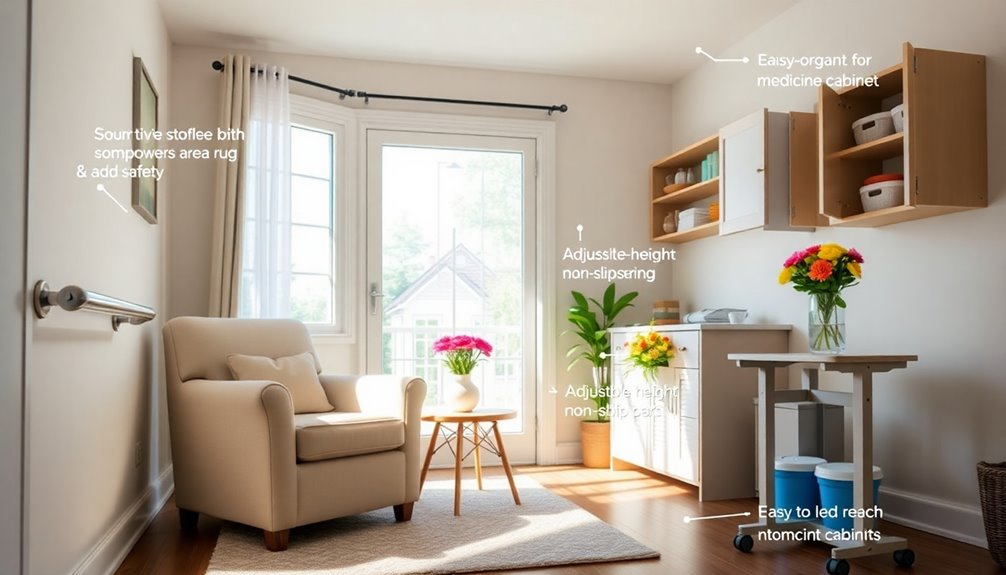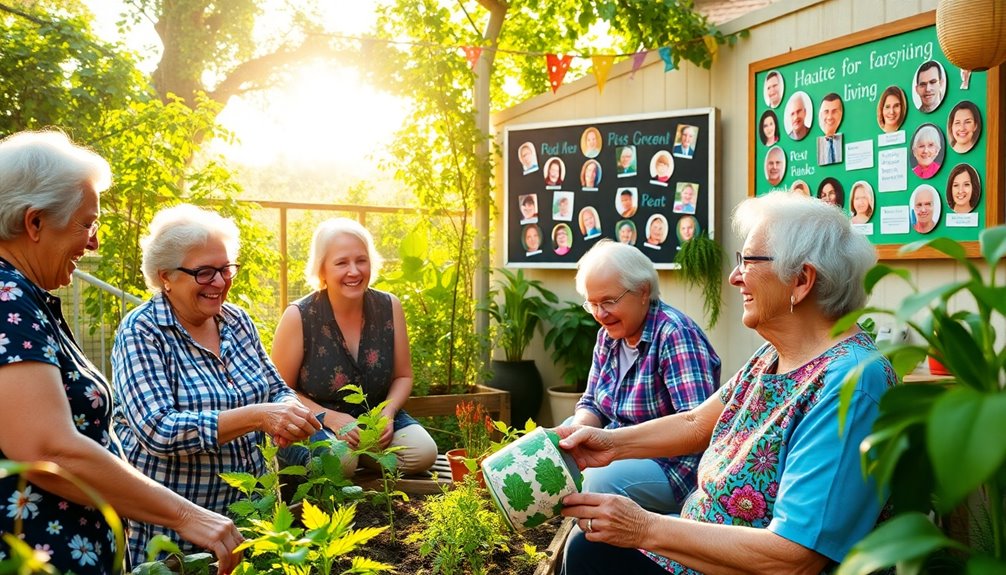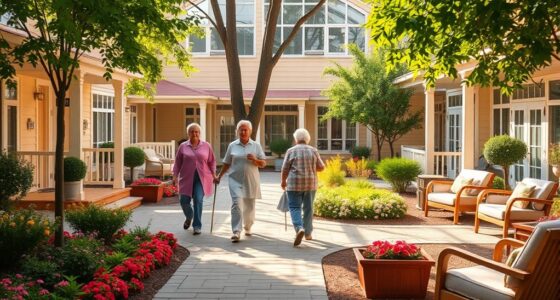You won't believe how easy it is to enhance elderly care while saving time and money! Streamline grocery shopping with weekly meal plans to cut impulse buys. Make efficient home modifications, like installing grab bars and non-slip surfaces for safety. Establish daily routines to boost independence and foster community connections for social engagement. Plus, implement budget-friendly health management strategies to keep costs down. Keep going to discover even more incredible hacks at your fingertips!
Key Takeaways
- Implement weekly meal planning to reduce grocery costs and minimize impulse purchases.
- Utilize technology for grocery pickup or delivery to save time and avoid in-store distractions.
- Establish consistent daily routines to enhance structure and reduce stress in elderly care.
- Create a budget prioritizing retirement savings to ensure financial stability in later years.
- Regularly review and adjust health screenings to catch potential issues early and reduce future healthcare expenses.
Streamline Grocery Shopping With Meal Plans

When you create a weekly meal plan, not only do you minimize impulse buys, but you also guarantee you purchase only the essential ingredients. This is one of the best things you can do for your budget.
Make sure to check grocery store flyers and apps for weekly sales, allowing you to plan meals around discounted items. Incorporating batch cooking helps you prepare larger quantities, saving time and reducing grocery trips.
Keep a well-organized shopping list based on your meal plan to avoid unnecessary purchases and cut down on food waste. You might also consider grocery pickup or delivery services. They're great for sticking to your list while helping someone avoid those tempting in-store distractions. Additionally, implementing a budget that accommodates income fluctuations can further enhance your financial management while planning meals for the elderly.
Efficient Home Modifications for Safety

To keep your home safe for elderly loved ones, consider implementing non-slip flooring solutions and essential bathroom safety features. You can also design an accessible kitchen that makes everyday tasks easier and safer. These modifications not only reduce hazards but also promote independence and confidence at home. Additionally, incorporating proper insulation can enhance thermal comfort and energy efficiency, making the home environment more pleasant for seniors.
Non-slip Flooring Solutions
Ensuring safety at home for elderly loved ones often starts with the right flooring choices. Installing non-slip flooring materials like textured vinyl or rubber can greatly prevent slips, reducing the risk of falls, which are a leading cause of injury among seniors.
In high-traffic areas, adding non-slip rugs with rubber backing can provide extra traction. For stairs and bathrooms, adhesive non-slip strips offer better grip, especially in moisture-prone areas.
Regular maintenance, such as cleaning and applying anti-slip coatings, helps prolong these non-slip properties, ensuring ongoing elderly safety. Additionally, implementing financial considerations for elderly care can assist families in budgeting for necessary home modifications.
Finally, opting for low-gloss finishes minimizes glare, making navigation easier for seniors with vision impairments. These simple modifications can create a safer living environment for your elderly loved ones.
Bathroom Safety Features
Creating a safe environment extends beyond flooring choices; bathroom safety features play a vital role in preventing accidents.
By making a few simple modifications, you can take care of your loved ones and enhance their independence. Here are some effective Home Hacks to keep in mind around your house:
- Install grab bars in showers and beside toilets for support.
- Use non-slip mats or adhesive strips in the bathtub and on floors to prevent slipping.
- Think about a raised toilet seat for easier sitting and standing.
- Utilize a shower chair to allow safe bathing while seated.
These modifications not only provide safety but also promote confidence and comfort. Additionally, consider the long-term benefits of eco-friendly practices that can contribute to a healthier living environment.
Make your bathroom a secure space for everyone!
Accessible Kitchen Design
While the kitchen is often the heart of the home, it can also pose challenges for elderly individuals.
To create an accessible kitchen, consider incorporating pull-out shelves and drawers in lower cabinets. This minimizes bending and reaching, making it easier to access items.
Install lever-style faucets for better grip and control, especially for those with limited hand strength. A raised countertop or adjustable height table can offer a more convenient workspace for meal prep.
Don't forget non-slip flooring to reduce slip risks. Arrange frequently used items on lower shelves to promote independence.
Additionally, consider using an air purifier to enhance indoor air quality, which can benefit overall health and well-being. If you're ready to buy something to enhance safety, let's talk about these modifications that make a world of difference!
Enhance Independence With Daily Routines

Establishing a consistent daily routine can greatly boost an elderly person's independence by providing structure and predictability in their lives.
By creating simple, enjoyable habits, you can empower your loved ones to thrive in their favorite home. Here are some tips to enhance daily routines:
- Incorporate a morning stretch or walk to improve mobility and health.
- Use checklists or visual schedules for medication and appointments.
- Plan regular phone calls or community events to combat isolation.
- Ascertain they get enough sleep to maintain energy and focus.
These strategies not only foster self-sufficiency but also help seniors navigate their environment with confidence, promoting a fulfilling and independent lifestyle.
Foster Community Connections for Social Engagement

Maintaining a structured daily routine can lead to greater independence, but it's just as important to foster community connections. Engaging in local activities can greatly reduce feelings of loneliness and enhance your mental and physical health. Here are some ways to promote social engagement:
| Activity Type | Benefits |
|---|---|
| Local Clubs | Opportunities for friendships |
| Volunteering | Intergenerational connections |
| Community Events | Sharing wisdom and experiences |
| Technology Use | Maintaining relationships easily |
Participating in group trips or classes boosts your mood and quality of life. Plus, using social media or video calls keeps you connected with family and friends. Prioritizing these connections can lead to a longer, healthier life. Additionally, engaging in local activities can enhance digital creativity through collaboration and innovation, which are vital for a fulfilling social experience.
Implement Budget-Friendly Health Management

Effective health management doesn't have to break the bank, especially when you prioritize preventive care and community resources.
By taking these steps, you can save time and money while staying healthy:
- Schedule regular health screenings to catch potential issues early, avoiding costly treatments later.
- Automate savings for healthcare expenses, ensuring you're prepared for out-of-pocket costs without stress.
- Utilize community health programs that offer free or low-cost screenings and vaccinations.
- Engage in preventive care measures, like immunizations and wellness checks, to notably reduce health risks and expenses. Additionally, consider community health programs that may provide valuable resources and support for ongoing health management.
Prioritize Regular Health Screenings

While you may not think about it often, prioritizing regular health screenings can be one of the most impactful steps you take for your well-being as you age.
These screenings are essential for early detection of health issues, potentially reducing mortality rates for conditions like breast and cervical cancer by up to 30%.
If you're 50 or older, the American Medical Association recommends a colorectal cancer screening every ten years, which greatly enhances treatment outcomes.
Annual physical exams help you manage chronic conditions effectively, increasing your chances of staying healthy by 20%.
Plus, preventative screenings, like cholesterol checks, can save you around $2,000 in future healthcare costs.
Staying on top of your health screenings empowers you to improve your quality of life.
Cultivate Financial Stability for the Future

To cultivate financial stability for your future, start by creating a budget that prioritizes retirement savings. Regular health screenings can help you manage potential health costs, while therapy supports your mental wellness. Additionally, consider utilizing backdoor Roth IRAs to enhance your retirement savings and achieve tax-free growth.
Budgeting for Retirement Savings
Planning for retirement can feel overwhelming, but starting early can make a significant difference in your financial future. Here are some practical tips to help you budget effectively for retirement savings:
- Save at least 15% of your income to build a solid nest egg.
- Take advantage of employer-sponsored retirement plans like 401(k)s, especially with matching contributions.
- Consider an Individual Retirement Account (IRA) for tax advantages while saving.
- Regularly review and adjust your strategy to account for inflation and living expenses.
Using budgeting tools and apps can also help you track your savings and identify areas to cut back, ensuring you maximize your contributions. Additionally, understanding credit score implications can improve your financial options as you prepare for retirement.
Taking these steps can lead you toward a more financially secure retirement.
Regular Health Screenings Importance
Regular health screenings can catch potential health issues early, leading to more effective treatments and lower healthcare costs down the line. For instance, women aged 21–65 should have Pap smears every three years and begin mammograms at 40, while men should start prostate screenings at 50.
Additionally, preventative checks like cholesterol and blood pressure assessments empower you to make lifestyle changes that can save you money on future medical expenses. Regular dental check-ups can also play a crucial role in preventing long-term dental issues, ensuring that your overall health—and finances—stay on track as you age.
Annual physicals help monitor existing conditions and identify new problems before they escalate, ensuring your health—and finances—stay on track as you age.
Therapy for Mental Wellness
While many focus on physical health as a cornerstone of financial stability, neglecting mental wellness can undermine your financial decisions. Engaging in therapy offers emotional support and coping strategies, reducing anxiety and enhancing your focus on finances.
Regular sessions can boost your productivity, helping you manage money more effectively.
Consider these benefits of therapy for mental wellness:
- Improved decision-making by addressing emotional spending habits
- Enhanced discussions about retirement and investment strategies
- A positive mindset towards budgeting and savings
- Increased productivity, allowing you to pursue long-term financial goals
Create a Comfortable Living Environment

Creating a comfortable living environment for the elderly is essential for their well-being and safety. Start by ensuring adequate lighting in living spaces, especially in high-traffic areas and staircases, to prevent falls.
Use non-slip mats and rugs in bathrooms and kitchens to enhance stability on wet surfaces. Adjust heating and cooling systems to maintain a temperature between 68°F to 72°F for ideal comfort.
Incorporate ergonomic furniture that offers proper support, such as chairs with armrests and adjustable heights, to ease daily activities.
Finally, minimize clutter to create a spacious and navigable environment, reducing the risk of falls and disorientation.
These simple adjustments can greatly enhance the quality of life for elderly individuals.
Nurture Friendships for Emotional Support

Friendships play an essential role in emotional well-being, especially as we age. Maintaining strong social connections can markedly enhance your quality of life and even increase your longevity by 50%.
Engaging regularly with friends helps combat feelings of loneliness and depression, which affect many older adults. Plus, friendships provide crucial emotional support during life changes.
Here are a few ways to nurture those connections:
- Schedule regular catch-ups, whether in person or via video calls.
- Join local clubs or groups that align with your interests.
- Volunteer together to build a sense of purpose.
- Share hobbies or explore new interests with friends.
Simplify Daily Tasks to Save Time and Effort

Maintaining strong friendships can enrich your life, but it's also important to simplify daily tasks to reduce stress and save time.
Start by implementing a daily routine that includes set times for meals, medication, and activities. This structure helps reduce confusion and saves time on decision-making.
Meal prep strategies, like batch cooking and freezing meals, guarantee nutritious options are always available.
Use a centralized calendar or digital reminders for appointments and important dates to keep everything organized.
Incorporate assistive devices, such as jar openers or reachers, to make chores easier.
Finally, create a designated space for frequently used items like keys, glasses, and medications to streamline your daily searches and save valuable time.
Frequently Asked Questions
What Are Some Low-Cost Meal Planning Resources for Seniors?
For low-cost meal planning resources, you can start by checking out local community centers or senior centers, which often offer free workshops.
Online platforms like Pinterest provide budget-friendly meal ideas tailored for seniors.
Additionally, apps like Mealime or Yummly allow you to customize meals based on dietary needs.
Don't forget to explore local food banks, as they sometimes offer meal planning guidance along with nutritious food supplies.
How Can Technology Assist in Elderly Care at Home?
Imagine technology as a lifeline, connecting you to the world of elderly care. Smart home devices can monitor health, sending alerts directly to your phone.
Video calls let loved ones check in, brightening your day like sunshine breaking through clouds. Medication reminders keep schedules on track, ensuring no pill's forgotten.
With apps for meal planning and grocery delivery, you're not just managing care; you're enhancing quality of life in a seamless, supportive way.
Are There Grants Available for Home Modifications for Seniors?
Yes, there are grants available for home modifications for seniors.
You can explore programs like the Department of Housing and Urban Development's (HUD) Home Improvement Program or local initiatives designed to support elderly individuals.
These grants often cover necessary changes, such as installing ramps or grab bars, making your home safer and more accessible.
It's worth checking with your local agencies or nonprofit organizations to find specific opportunities in your area.
What Are Effective Ways to Engage Seniors in Community Activities?
To engage seniors in community activities, you can start by organizing regular social events like game nights or book clubs.
Encourage them to participate in local volunteer opportunities, which can foster a sense of purpose.
Consider offering transportation services to make it easier for them to attend activities.
You might also tap into their interests by hosting workshops or classes that reflect their hobbies, ensuring they feel valued and connected to the community.
How Can Caregivers Manage Their Own Stress Effectively?
In today's fast-paced world, you can't afford to ignore your own well-being.
As a caregiver, managing stress is vital for both you and those you care for. Start by setting boundaries; don't hesitate to take breaks.
Engage in activities you love—whether it's a walk or a good book. Connecting with support groups can lighten the load.
Conclusion
By adopting these ten incredible elderly care hacks, you can greatly enhance the quality of life for your loved ones while saving both time and money. For instance, consider the case of Mary, who implemented a meal planning strategy that cut her grocery expenses by 30% and reduced food waste. With a little creativity and effort, you can create a safer, more enjoyable environment that fosters independence and emotional well-being for the elderly in your care.









